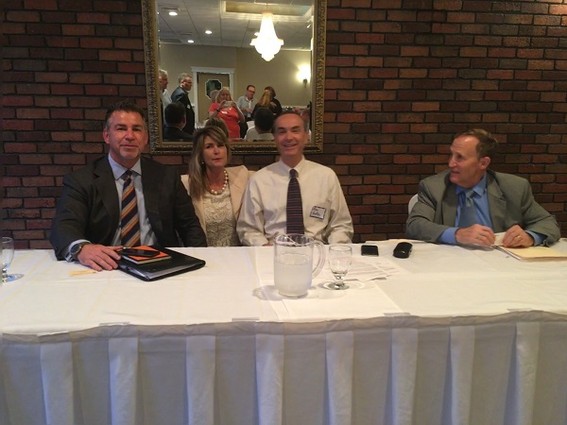June AITP Meeting Puts IT and Tech Careers in Focus

Panelists at the fourth annual career event of the Association of Information Technology Professionals’ Garden State Chapter were asked to consider what job hunting and career paths look like in an age when companies are not loyal to their employees and change is constantly disrupting jobs.
The panel, held in Clark June 13, was moderated by Jessica Carroll, vice president at IT solutions company TenFour (Morristown) and institute fellow at the Institute for Digital Transformation (Bridgewater). The panelists included Dave Wight, president of Performance Leadership Systems (Port Murray); Anthony Curlo, president and CEO of IT recruiter DaVinciTek (Morristown); and Ronald Hadley, director of employee development partners at the IEEE (New York and Piscataway).
When jobs are constantly being disrupted, it’s essential for IT professionals to stretch themselves professionally, Wight said. “Most people immediately think of training” when it comes to acquiring new skills, but the most valuable lessons are learned are hands-on.
“So, what I strongly suggest, and this is what we did in our career development program that I designed for BASF, is for people to look for work experiences…that give you the opportunity to develop that particular skill.” He added that for IT employees developing a professional presence is important, and is often done by improving presentation skills and finding opportunities to make presentations. “Higher ups in a company leap to conclusions about your potential” based on how you present yourself, he said.
Finding these opportunities is sometimes not easy, and a manager may not know or care about helping you develop these skills, he added. That’s why it is essential to develop a network. “Go to your network and ask them if they know what kind of job or work experience I can have that would help develop this.”
Curlo strongly recommended that job hunters and those wanting to stretch themselves read “Poke the Box,” by Seth Godin. “It is something I use for all my employees; we give it out to our clients. It’s 83 pages, takes all of about a half hour to read. What Seth asks in this book is ‘when was the last time you did something for the first time?’ It’s getting out of your comfort zone and applying yourself.”
The panel spent some time discussing professional presence, which Curlo said has three dimensions: style, substance and character. Style includes the image, mannerisms, and interpersonal behavior. The most important element is substance, as leaders without substance are perceived to be “an empty suit,” he said.
Hadley added that it goes without saying that professional presence involves being well-groomed, dressing right and all the things that go with it. However, there is more. When you get into a room, you have to believe that you are going to hit the ball out of the park. “You have to have self-confidence.”
Wight pointed out that telling someone to be self-confident doesn’t work, so “if you don’t feel it, fake it.” Curlo said that, in his experience, getting the skills you need can go a long way towards creating self-confidence. He noted that two of his senior recruiters used this method to become more confident in matching candidates to tech jobs. They attended a course at a community college, going out of their comfort zones, to learn what they needed to know.
Hadley said that IT professionals are sometimes on the market because of a change at a company, and it’s a tricky business. “We have to help organizations through the change, and whatever that means in your particular area, that’s what you need to focus on.”
When interviewing, however, you need to demonstrate that you’ve mastered two very different skill sets. The first is that you can get the job done and get it done accurately, that you can make things happen. The other is that you can be creative and work outside the box. “I think it’s important to be able to demonstrate that you can do both.” He noted that candidates should have examples of how they’ve applied both skills to present at an interview.
When it’s time to change jobs, it’s important to create a brand and have that information out there, so that your brand can be seen on all social platforms, Curlo said. Carroll added, “Your brand must be consistent across all platforms and channels of interaction. It is the message you have on your resume. It’s your LinkedIn profile. It’s Twitter.” Speaking of Twitter, she added, “I don’t know why most people don’t use that to market their businesses. It’s a great tool for that.”
“I think you need to think of your brand as something that will differentiate you from other people out there and make them remember you,” Wight noted. “It can be either positive or negative. And you don’t want it to be negative.”
When sending out resumes, job hunters should know that recruiters look at a resume for all of 9 seconds, Curlo said. They may then go look at a LinkedIn profile. “We look for common connections and who knows who.” They reach out to those folks before they even talk to the candidate.
Wight said that the key for tech employees is maintaining the level of, and staying current with, their technical skills. “I emphasize the technical skills because that’s what makes you IT professionals.” He added that, while it’s good to have the soft skills like communications capabilities, having current tech skills is what will make you marketable.
Summing up the event, Carroll noted that we live in an age of disruption, and that includes the disruption of jobs. Younger people are used to this, but some of the older workers may have trouble adapting. “But having a brand, having your professional presence, making sure you stretch yourself, getting comfortable out in front of people, and networking” can help make this transition easier.

